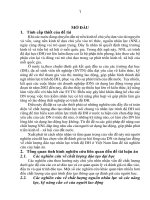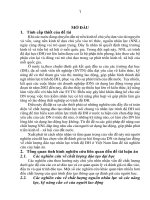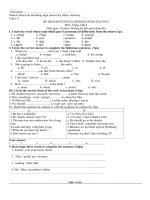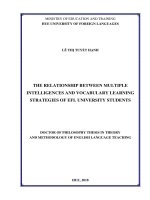SỰ gắn kết CỦA SINH VIÊN VÀ mối QUAN hệ với CHẤT LƯỢNG CUỘC SỐNG đại HỌC tt tiếng anh
Bạn đang xem bản rút gọn của tài liệu. Xem và tải ngay bản đầy đủ của tài liệu tại đây (1.28 MB, 28 trang )
MINISTRY OF EDUCATION AND TRAINING
UNIVERSITY OF ECONOMICS HO CHI MINH CITY
Nguyễn Thị Đoan Trân
THE RELATIONSHIP BETWEEN STUDENT
ENGAGEMENT AND QUALITY OF COLLEGE LIFE
Major: Business administration
Code: 9340101
SUMMARY OF DISSERTATION
Ho Chi Minh City - 2020
The research was conducted and completed at University of
Economics Ho Chi Minh city:
Academic advisors:
• Prof. Đoàn Thị Hồng Vân
• Assoc. Prof. Bùi Thanh Tráng
Reviewer 1: …………………………………………………
Reviewer 2: …………………………………………………
Reviewer 3: …………………………………………………
The dissertation will be defended at University of Economics Ho
Chi Minh City at
hour day month year
The dissertation can be found at the following library:
………………………………………………………………
………………………………………………………………
1
Chapter 1. INTRODUCTION
1.1.
Problem statement
Over the past decades, higher education institutions (HEIs) have
undergone the process of extension and transition, and also confronted
a variety of challenges, both domestically and internationally (Chen,
2016; Dao & Thorpe, 2015; Koszembar-Wiklik, 2016). Technological
revolution context and trends will dramatically alter the higher
education landscape. Colleges, as a result, will no longer enjoy their
knowledge provision monopoly, but are supposed to further
accentuate their role in inspiring students to show positive learning
attitude or educating them in self-training and lifelong pursuit of
knowledge. As for students, various options are open to them in terms
of locations and methods for knowledge gain. Such changes have
influenced the way today’s HEIs operate and these are seen as a
driving force behind higher education marketing. Therefore, the
improved quality of training services, learner attraction matters, and
other marketing activities to cater for students (also considered direct
customers) become more crucial than ever.
This very issue has been vividly identified by examining
student engagement from the multidirectional perspective, and it is
thus recommended for research to ameliorate such substantial
consequences as learning outcome or quality of academic life (Kahu,
2013). In this context, the author decides to take account of student
engagement based on Fredricks et al.’s (2004) cognitive and
emotional dimensions for an investigative study carried out for this
thesis.
1.2.
Research topic
Given existing literature, few studies have explored how student
engagement is affected by cognitive dimensions or learner’s personal
2
characteristics, namely perceived service value, purpose in life,
absorptive capacity, and grit. While predominantly capturing the
impact of external factors (parents, teachers, friends, colleges, etc.) or
student perception of external factors (motives, learning missions,
familiarity, etc.) on engagement decision, previous studies scarcely
consider different factors of personal characteristics. Also detected by
the author is the fact that several consequences of student engagement,
as documented in most literature, are academic achievement, school
dropouts, and student satisfaction, whereas happiness, or quality of
school life, has not specifically been considered. In this regard, this
thesis investigates the topic of student engagement on the basis of the
mentioned gap.
1.3.
Research objectives
The overall objectives of the research are to unveil: (i) how
cognitive dimensions and personal characteristics (including perceived
service value, absorptive capacity, purpose in life, and grit) affect
student engagement; and (ii) the linkage between student engagement
and quality of college life.
1.4.
Research questions
How can cognitive dimensions and personal characteristics be
measured and to which extent do they impact student engagement?
Besides independent variables, which factors will be explored with
their moderating role?
How does student engagement affect quality of college life?
Among the four cognitive dimensions and personal characteristics,
which has an effect on quality of college life?
Is there any difference in quality of college life between
students of different gender and geographical locations?
3
Do students of different training programs differ in the
associations that cognitive dimensions and personal characteristics
have with student engagement and quality of college life?
What solutions can be adopted to enhance student engagement
and quality of college life?
1.5.
Research participants
Survey participants consist of: (i) Full-time first degree students
(those devoting most of their daytime to the course of study on a fulltime basis); and (ii) Part-time students (those trained at HEIs or
affiliated institutes that well meet their demands), including in-service
and Master’s students.
1.6.
Research scope
This research is expected to shed some light on a single
scientific matter, which is student engagement in public universities
specializing in economics/business education. The sample, therefore,
will be collected from five top public universities in Vietnam, whose
headquarters are based in Hanoi and Ho Chi Minh City, two centers
taking a crucial part in training high-quality human resources across
the country. These comprise National Economics University (NEU),
Foreign Trade University (FTU) (main campus), University of
Economics Ho Chi Minh City (UEH), VNUHCM-University of
Economics and Law (UEL), and University of Finance and Marketing
(UFM).
1.7.
Data and methods
The data are collated from a sample of 1,435 students. CFA and
SEM are employed to test the research model and hypotheses,
respectively.
4
1.8.
Significance of the research
First, given theoretical contribution, this study re-tests and adds
to the scale system six dimensions under discussion including
perceived service value, absorptive capacity, purpose in life, grit,
student engagement, and quality of college life in the current context
of Vietnam’s market. The findings are novel, concerning the linkages
between cognitive dimensions and personal characteristics (perceived
service value, absorptive capacity, purpose in life, grit) and student
engagement, and the role of student engagement in their quality of
college life. The study also highlights the substance of the selfdetermination and absorptive capacity theories in clarifying the issue
of student engagement in addition to checking the moderating role of
the factors of personal characteristics in the association between
perceived service value and student engagement. Besides, the new
research model (with four independent variables, two dependent
variables, pure and mixed moderating variables concurrently analyzed
using quantitative research methods, control variables, and group
moderating variables) underlines the research method contribution.
Second, with regard to practical contribution, the findings
provide the educational management and/or university administrators
with some material reference which allows enhanced service value
based on learners’ perception, reduced student burnout and dropout
rates, increased positive learning, and thus improved quality of college
life or greater satisfaction derived from the service obtained. This also
results in learners’ positive evaluation, recommendation, and
promotion of their future’s college. Furthermore, the thesis is a
general
reference
work,
useful
for
policy-makers,
researchers/practitioners, and others, on student engagement at
colleges and universities.
5
Chapter 2. THEORETICAL BASES AND RESEARCH MODEL
2.1.
Review of empirical studies
This section is presented based on two primary discussion
points, namely: (i) constructs viewed as antecedents and consequences
of student engagement; and (ii) descending order of appearance by the
level of popularity detected. As such, antecedents with impact on
student engagement comprise school environment (teachers, friends,
classroom structure, schools, and school officials), parents,
motivation, perceptions, learning missions, confidence in ability,
familiarity, character traits, personal emotions, games for learning
goals, learners’ skills, grit, and purpose in life. Consequences that
affect student engagement consist of performance, dropout rates, and
student satisfaction.
2.2. Constructs of the research model
2.2.1. Student engagement
As defined by Fredricks et al. (2005) and Yusof et al. (2017),
student engagement is a meta-construct illustrating how students
behave, feel, and think at school. It consists of three dimensions:
behavioral, emotional, and cognitive engagement.
2.2.2. Perceived service value
LeBlanc and Nguyen (1999) were of the opinion that
educational service value, perceived by students, is their overall
assessment of the utility of the service provided by HEIs through
awareness of what they give and what they get in the process of using
the service.
2.2.3. Absorptive capacity
Absorptive capacity is such that students gain knowledge from
business schools, which includes recognition of the value of the
6
knowledge, assimilation of it, linking it with the knowledge already
possessed, and applying it to their daily tasks (Cohen & Levinthal,
1990; Mariano & Walter, 2015; Tho, 2017).
2.2.4. Purpose in life
The definition of purpose in life is derived from valued goals,
which are fundamentally substantial due to providing the purpose to
live (Scheier et al., 2006), and therefore in line with the intention to
figure out what prompts students to act and maintain their engagement
at colleges and/or universities.
2.2.5. Grit
Grit manifests itself through perseverance and passion to
accomplish long-term goals or lasting survival ability (Duckworth et
al., 2007). It is also shown by attempts to maintain resilience capacity,
conscientiousness, self-control, and persistence with problem-solving
measures (Bashant, 2014).
2.2.6. Quality of college life
According to Sirgy et al. (2007) and Nguyen et al. (2012),
quality of college life refers to students’ overall satisfaction with
college life, or more precisely, their contentment found with
educational experiences throughout the years of studying and living at
their institutions.
2.3. Theoretical background
2.3.1. Review of background theories and basis for selecting selfdetermination theory (SDT)
Apart from reviewing empirical studies to explore the research
gap, the study also looks at the background theories suggested in
previous studies to opt for the most appropriate one. In general, there
are many that examined the factors that facilitate student engagement
to minimize dropouts and improve academic performance as well as
7
satisfaction on quality of college life, and one of these, which was
most commonly employed, is self-determination theory (SDT).
Moreover, according to Ryan and Deci (2017), theoretically,
major theories in Western psychology of the twentieth century
predominantly highlighted the tendency of an individual, without
adequate attention to the idea that each individual is embedded within
a social organization, and the individual within it is integrated more or
less. Therefore, SDT primary concern is how the universal features of
human nature (above all, the basic needs), are expressed in a different
and satisfied manner through the cultural context, thereby affecting
both personal and social well-being. SDT results indicate that the
satisfaction of certain desires or actual motives may well be related to
illnesses rather than healthiness or well-being (Kasser & Ryan, 2001;
Niemiec & Ryan, 2009).
2.3.2. Self-determination theory (SDT)
SDT is an empirically based theory involving human behavior
and personality development. It principally addresses psychological
aspects, classifying various types of motivation that are constantly
changing from control to autonomy, and particularly how social
context-related factors advocate or hinder an individual's development
by means of fulfillment of basic psychological needs, including
competence, relatedness, and autonomy. The theory has been centrally
applied in different fields such as education, health care,
psychotherapy, sports, and the virtual world, examining the social,
political, and cultural dimensions influencing human motivation and
satisfaction of basic needs (Ryan & Deci, 2017). Specifically, in
education SDT aims at motivating learners to take a keen interest in
learning, valued education, and confidence in competence and
attributes (Deci & Ryan, 1985; Deci et al., 1981).
8
2.3.3. Six sub-theories of SDT
The six main sub-theories of SDT comprise cognitive
evaluation theory (CET), organismic integration theory (OIT),
causality orientation theory (COT), basic psychological needs theory
(BPNT), goal contents theory (GCT), and relationships motivation
theory (RMT).
Specifically, CET posits that intrinsic motivation relates to the
performance of a desired action which leads to the natural satisfaction.
Many a scenario and/or situation enhance or diminish intrinsic
motivation. Next, OIT seeks to analyze and interpret different levels
of extrinsic motivation in an ascending order of their relative
autonomy, namely externally regulated behavior, introjected
regulation of behavior, regulation through identification, and
integrated regulation. The third mini-theory, COT, argues that
causality orientation is a tendency to focus on a few environmental
aspects and internal competency related to the motivation and causes
of behavior that affect certain motivations, general needs, behavior,
experiences, and also the efficiency of human engagement with the
surrounding environment and psychological well-being. According to
BPNT, basic needs are the basis for accelerating the process of: (i)
intrinsic motivation, (ii) internalization and integration of behavioral
regulation and social regulations and values, bringing about
psychological engagement and integrity, and (iii) experiences of
wellness and vitality. GCT views goals and life aspirations as a source
of motivation that prompts humanity to pursue and achieve their goals
and basic need satisfaction, other motivations, and happiness. Last,
RMT accentuates the role of needs for relatedness, which help
individuals in their building, adjusting, maintaining, and enhancing
the quality of close relationships with openness through positive
experiences and levels of autonomy respect.
9
2.3.3. Absorptive capacity theory
Cohen and Levinthal (1990) successfully proposed the concept
of absorptive capacity as the ability to process knowledge by
recognizing value, assimilating it, and applying new knowledge. Since
then, this concept has been widely utilized and rapidly developed in
many fields, both theoretical and empirical research, with more than
1,300 citations and over 600 published articles (Volberda et al., 2010).
Thus, the theory of absorptive capacity refers to the ability to identify,
acquire, integrate, and apply new inputs to enhance competitiveness
(Nguyen, 2017). Absorptive capacity allows employees to identify,
learn, and gain new knowledge from external sources essential to their
current job (Cohen & Levinthal, 1990). Overall, pioneered by Cohen
and Levinthal (1990), the absorptive capacity theory would form a
sound basis for substantial arguments for the relationships in the
research models involving absorptive capacity (Harvey et al., 2015;
Lane et al., 2006).
2.4. Research model
2.4.1. Hypotheses
H1: Perceived service value (PSV) positively affects student
engagement (SE).
H2: Absorptive capacity (AC) positively affects student
engagement (SE).
H3: Absorptive capacity (AC) moderates the relationship
between perceived service value (PSV) and student engagement (SE).
H4: Purpose in life (PL) positively affects student engagement
(SE).
H5: Purpose in life (PL) moderates the relationship between
perceived service value (PSV) and student engagement (SE).
H6: Grit (GR) positively affects student engagement (SE).
10
H7: Student engagement (SE) positively affects quality of
college life (QL).
H8: Perceived service value (PSV) positively affects quality of
college life (QL).
H9: Purpose in life (PL) positively affects quality of college life
(QL).
Additionally, due to the intention to investigate whether any
difference exists in the relationships established in the theoretical
framework between full-time and part-time students, the study makes
the following predictions.
P1: The relationship between perceived service value (PSV) and
student engagement (SE) of full-time students is weaker than that of
part-time students.
P2: The relationship between absorptive capacity (AC) and
student engagement (SE) of full-time students is weaker than that of
part-time students.
P3: The relationship between grit (GR) and student engagement
(SE) of full-time students is weaker than that of part-time students.
P4: The relationship between purpose in life (PL) and student
engagement (SE) of full-time students is weaker than that of part-time
students.
P5: The relationship between student engagement (SE) and
quality of college life (QL) of full-time students is stronger than that
of part-time students.
P6: The relationship between perceived service value (PSV) and
quality of college life (QL) of full-time students is weaker than that of
part-time students.
P7: The relationship between purpose in life (PL) and quality of
college life (QL) of full-time students is weaker than that of part-time
students.
11
2.4.2. Theoretical model
Grit
[GR]
Purpose in life
[PL]
H6
H9
H4
H5
Student
Engagement [SE]
H1
H7
Quality of college life
[QL]
H8
Perceived Service
Value [PSV]
H3
H2
Absorptive
Capacity [AC]
Figure 2.1. Theoretical model
(Source: Author’s proposal)
Chapter 3. RESEARCH DESIGN
3.1.
Research design
3.1.1. Research procedures
The study follows quantitative research procedures with tests on
theoretical perspectives (Nguyen Dinh Tho, 2013). These include
three key steps, namely theoretical research, preliminary quantitative
research, and formal quantitative research, as illustrated in Figure 3.1.
12
STEP 1 ---------------------------------------------------------------------------------------------------------------------- Context/ideas
- Topic
Peer/group
Draft
Adjustments
- Objectives
discussion
scales
- Theoretical bases
STEP 2 -----------------------------------------------------------------------------------------------------------------------Final draft
scales
Preliminary
quantitative
research (n = 422)
Cronbach's Alpha
analysis
Confidence
intervals
Exploratory factor analysis
(EFA)
Total variance explained
EFA
Officially used scales
STEP 3 ---------------------------------------------------------------------------------------------------------------------------Formal quantitative
research (n=1.435)
Confirmatory factor analysis (CFA)
Composite reliability
Total variance explained
CFA
SEM
Model fit testing
Hypothesis testiing
Nomological validity testing
Results
Academic and practical significance
Figure 3.1. Research procedures
(Source: Author’s proposal)
13
3.1.2. Constructing scales
Table 3.1. Scales of Student Engagement
Symbol Items
Emotional Engagement (EE)
EE1
I like being at school.
EE2
I feel excited by my work at school.
EE3
My classroom is a fun place to be.
EE4
I am interested in the work at school.
EE5
I feel happy in school.
Cognitive Engagement (CE)
CE6
I pay attention in class.
CE7
I complete my work on time.
CE8
I study at home even when I don't have a test.
CE9
I try to watch TV shows about things we do in school.
CE10 I read extra books to learn more about things we do in
school.
CE11 If I don't know what a word means when I am reading, I do
something to figure it out.
CE12 If I don't understand what I read, I go back and read it over
again.
CE13 I talk with people outside of school about what I am learning
in class.
(Source: Yusof et al. (2017))
Table 3.2. Scales of Perceived Service Value
Symbol Items
Functional Value (want satisfaction) (FS)
FS1
A degree in business will allow me to earn a good salary.
FS2
A degree in business will allow me to achieve my career
goals.
14
Symbol
FS3
Items
The knowledge I have acquired at my business school will
allow me to get promotions.
FS4
I believe employers are interested in hiring students from my
business school.
FS5
A degree from my business school is a good investment.
FS6
It is better to obtain a post secondary degree than to enter the
workforce immediately after high school.
Epistemic Value (EP)
EP7
The quality of education received from my professors
influences the value of my degree.
EP8
Course content influences the value of my education.
EP9
The number of students in my classes influences the value of
my education.
EP10
The guidance received from professors effects the value of
my education.
EP11
I learn new things in many of my courses.
Image (IM)
IM12 I have heard positive things about my business school.
IM13 The reputation of my business school influences the value of
my degree.
IM14 The image projected by my business school has an influence
on the value of my degree.
IM15 I believe that employers would have positive things to say
about my business school.
Emotional Value (EM)
EM16 I like taking courses in business administration.
EM17 I am glad that I chose courses in business administration.
EM18 The value of my education depends on my personal effort.
Functional Value (price/quality) (FQ)
15
Symbol
FQ19
Items
When considering the price I pay for tuition, I believe that my
business school offers sufficient services.
FQ20 When considering the price I pay for tuition, I believe that the
price/quality ratio is good at my business school.
FQ21 I believe that my business school offers quality services
Social Value (SO)
SO22 I am happy when friends are in my classes.
SO23 I find courses more interesting when friends are in my classes
SO24 Working in groups has a positive effect on the value of my
education.
SO25 Social activities at my business school make my studies more
interesting.
(Source: LeBlanc and Nguyen (1999))
Table 3.3. Scales of Absorptive Capacity
Symbol
AC1
AC2
AC3
AC4
Items
I have the ability to recognize new knowledge and skills
provided by my instructors applicable to my current job.
I have the ability to absorb the new knowledge and skills
provided by my instructors.
I have the ability to integrate the new knowledge and skills
provided by my instructors with my prior knowledge.
I have the ability to apply the new knowledge and skills
provided by my instructors to my current job.
(Source: Tho (2017))
Table 3.4. Scales of Purpose in Life
Symbol
Items
PL1 There is not enough purpose in my life.
PL2 To me, the things I do are all worthwhile
16
Symbol
Items
PL3 Most of what I do seems trivial and unimportant to me.
PL4 I value my activities a lot.
PL5 I don’t care very much about the things I do.
PL6 I have lots of reasons for living.
(Source: Scheier et al. (2006))
Table 3.5. Scales of Grit
Symbol
Items
Consistency of Interests (CI)
CI1 I have been obsessed with a certain idea or project for a short
time but later lost interest.
CI2 I have difficulty maintaining my focus on projects that take
more than a few months to complete.
CI3 I often get a goal but later choose to pursue a different one.
CI4 New ideas and new projects sometimes distract me from
previous ones.
Perseverance of Effort (PE)
PE5 I finish whatever I begin.
PE6 I am diligent.
PE7 I am a hard worker.
PE8 Setbacks don’t discourage me.
(Source: Duckworth and Quinn (2009))
Importantly, grit is measured by such two dimensions as
consistency of interest (CI) and perseverance of effort (PE). In
estimating CI, reverse-scored items are employed for rational data
process.
Table 3.3. Scales of Quality of College Life
Symbol
Items
QL1 QL1. In general, how satisfied are you with your academic and
17
Symbol
Items
social life on campus? (very dissatisfied/ very satisfied)
QL2 QL2. In general, how satisfied are your friends and other
classmates with their academic and social life on campus? (very
dissatisfied/ very satisfied)
QL3 QL3. Considering all things, how happy are you with your study
at this university? (very unhappy/very happy)
QL4 QL4. Considering all things, how happy are your friends and
other classmates with their study at this university? (very
unhappy/very happy)
(Source: Sirgy et al. (2007) & Nguyen et al. (2012))
3.1.3. Overall assessment of scales
Initially used to test confidence levels of the scales are corrected
item-total correlations and Cronbach’s Alpha. Then, the EFA technique
is applied to evaluate discriminant validity and convergent validity of
the scales. The study also employs principal axis factoring along with
promax rotation in considering key criteria such as KMO statistic,
eigenvalue, number of factors extracted, factor loading, and TVE.
3.1.4. Formal quantitative research
3.1.4.1. Confirmatory factor analysis (CFA)
The CFA technique is first employed to assess the suitability of
the used scales in conjunction with market information through the
following criteria: Chi-square: CMIN, CMIN/df, GFI, CFI, TLI, and
RMSEA. Also, the scale evaluation indices are estimated, including:
(i) composite reliability; (ii) total variance explained; (iii)
unidimensionality; (iv) convergent validity; (v) discriminant validity;
and (vi) nomological validity.
3.1.4.2. Structural equation modeling (SEM)
For assessment of the suitability of the data for the market
context, the study utilizes SEM with criteria similar to the
18
aforementioned CFA method. The ML technique is also applied to
measure the model parameters. The estimation results (standardized)
of the parameters indicate the associations between the variables with
the well-defined significance level (p < 0.05).
3.1.4.3. Control variables
Besides the primary objectives, the study takes into
consideration the controlling role of gender and geographical regions
over quality of college life. These variables, employed as qualitative
variables, are dummy coded and incorporated in the SEM model for
analysis after the key independent variables have all been considered.
3.1.4.4. Group moderating role
The study uses the multi-group analysis method to account for
the differences between the models in training programs (including
full- and part-time education paths).
Chapter 4. DATA ANALYSIS AND RESEARCH FINDINGS
4.1. Estimation results of officially used scales
4.1.1. Sample description
Table 4.1. Sample characteristics
Number of
Group
participants
Full-time
690
Training
program
Part-time
745
Male
490
Gender
Female
945
Hanoi
581
Geographical
location
Hochiminh City
854
NEU
271
FTU
310
Training
Percentage
(%)
48.1%
51.9%
34.1%
65.9%
40.5%
59.5%
18.9%
21.6%
19
institution
UEH
UEL
UFM
323
252
279
1.435
Total
22.5%
17.6%
19.4%
100%
(Source: Author’s calculation)
4.1.2. CFA results
First, a test of measurement scales of multidimensional
concepts is to be conducted with satisfactory results. Then,
unidirectional scales are considered to further evaluate discriminant
validity of the studied concepts through the critical model. The CFA
results attained for the critical model indicate very good model fit to
the market data, and suggest that the scales applied all meet the
evaluation standards, as shown in Table 4.2.
Table 4.2. Summary of results of construct measurement scales
Confidence level
Cons
truct
PSV
Total
variance
explaine
d
Dimen
sion
Obs.
FS
5
0.825
0.812
47%
EP
4
0.795
0.804
51%
IM
4
0.817
0.828
55%
EM
3
0.737
0.769
55%
FQ
3
0.905
0.911
77%
SO
4
0.775
0.776
48%
EE
5
0.896
0.898
64%
CE
5
0.824
0.832
50%
Cronbach’s Compo
Alpha
site
SE
Valid
ity
Acce
ptabl
e
Acce
20
Confidence level
Cons
truct
Total
variance
explaine
d
Dimen
sion
Obs.
CI
4
0.842
0.823
54%
PE
4
0.795
0.803
51%
PL
4
0.817
0.829
55%
AC
4
0.888
0.882
65%
QL
4
0.887
0.901
69%
Cronbach’s Compo
Alpha
site
Valid
ity
ptabl
e
GR
(Source: Author’s calculation)
4.2.
Testing theoretical model and research hypotheses
Table 4.3. Regression coefficients (unstandardized) of the
relationships
Hypothesis
Relationship
se
cr
p-value
H1
PSV
SE
0.628
0.043
14.731
0.000
H2
AC
SE
0.090
0.026
3.497
0.000
H4
PL
SE
-0.004
0.034
-0.116
0.907
H6
GR
SE
0.282
0.074
3.818
0.000
H7
SE
QL
1.337
0.157
8.528
0.000
H8
PSV
QL
-0.063
0.108
-0.583
0.560
H9
PL
QL
-0.071
0.042
-1.681
0.093
Notes: : regression coefficient, se: standard error, cr: critical value, p-value: significance level
(Source: Author’s calculation)
The SEM results demonstrate that the four hypotheses H1, H2,
H6, and H7 are accepted at significance level of 0.1%, and that the
other three H4, H8, and H9 are rejected due to p-value > 5%.
21
4.3. Testing the model with moderating variables
4.3.1. Absorptive capacity (AC)
The SEM results suggest the suitability of the model with the
market data. Accordingly, the hypothesis H3 ( = 0.054; p < 0.01) is
accepted, meaning that AC is a true moderator, and the hypothesis H2
( = 0.122; p < 0.001) is also supported, thus implying that AC is a
mixed moderating variable.
4.3.2. Purpose in life (PL)
As shown by the SEM results, the model is plausible with good
model fit to the market data. The hypothesis H5 ( = 0.067; p < 0.001)
is accepted, meaning that PL is a moderator. Still, The hypothesis H4
(p > 0.05) is not supported; therefore, PL can merely serve as a pure
moderating variable.
Figure 4.1. Overall results (standardized) with SEM analysis
22
Taken together, the overall results of model parameter and
hypothesis test is depicted in Figure 4.1.
4.4.
Results of control variable analysis
The results show that the control variable ‘gender’ does not
explain the variance of quality of college life (p = 0.940 > 0.05),
which suggests that survey participants’ gender (male, female) exerts
no impact on their quality of college life. Concerning geographical
location, on the other hand, quality of college life differs between the
group of students residing in Hanoi and in Hochiminh City (p = 0.007
< 0.01).
4.5.
Results of group moderating variable analysis
It is found that only the prediction P2 is supported (t = 2.027 >
2), so absorptive capacity of the group of full-time students does not
impact positively on engagement (p = 0.996 > 0.05), but this is not the
case for part-time students (p = 0.001 < 0.01). The other predictions
P1, P3, and P5 are all not supported.
Chapter 5. CONCLUSION AND SIGNIFICANCE OF THE
STUDY
This study evidently identifies cognitive dimensions and
personal characteristics which have effects on student engagement and
also the linkage between student engagement and quality of college
life. A few outstanding results could be summed up as follows.
5.1.
Theoretical contribution
First, it sheds some light on the effects of the four factors of
cognitive dimensions and personal characteristics on student
engagement at Vietnam’s universities. The results are as follows: (i)
23
perceived service value and absorptive capacity impact positively on
student engagement, which remains unexplored in the existing
literature on higher education; (ii) concerning purpose in life, while
previous studies demonstrated its relation to student engagement, no
existence of such a linkage can be detected in this study; and (iii) grit
is found to have a positive association with student engagement,
which is consistent with earlier findings, but the estimation techniques
employed in the study are different.
Second, the study indicates the mixed (pure) moderating role of
absorptive capacity (purpose in life) in the relationship between
perceived service value and student engagement. These findings,
previously unattainable, are therefore of crucial importance.
Third, the result showing the profound influence of student
engagement on quality of college life is regarded as the empirical
evidence of how self-determination theory is applied in the context of
higher education, aside from evidence in other fields.
Fourth, the justification for the group moderating effect of type
of training, typified by difference levels of the linkage between
absorptive capacity and engagement of full- and part-time students, is
an exploratory result recommended for further research.
Last, the results of analysis, once again in line with earlier
findings, reject gender with its control over quality of college life.
Contrarily, region is accepted as a control variable as there exists a
gulf in quality of college life between two groups of students in Ho
Chi Minh City and Hanoi, which can be fundamentally exploited in
further studies.
5.2.
Research method contribution
First, specifically added to the existing scale system are
different concepts in the current context of the Vietnamese market,









